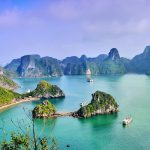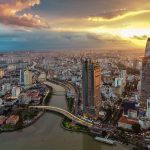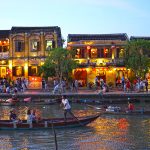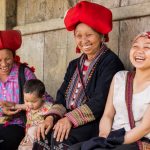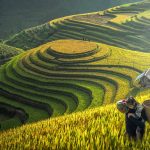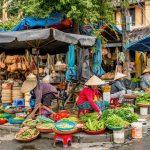If you have the bills, Vietnam has the thrills and chills. Some require a little physical effort, such as motorbiking switchback after switchback up the jaw-dropping Hai Van Pass in central Vietnam. Others require even more sweat: kitesurfing the tropical oceanic waters off Mui Ne or hiking the evergreen hills around Bac Ha or Sapa. And when you’re done with all that adrenaline stuff, there’s plenty of horizontal ‘me’ time to relish. Vietnam has outstanding spas – from marble temples of treatments to simple family-run massage salons with backpacker-friendly rates.
Money
The official currency in Vietnam is the Vietnamese Dong (VND). Although a handful of places will accept payment in US dollars most people would much prefer to be paid in Dong, so it is important to keep a good supply of local currency while travelling in Vietnam. The currency is effectively pegged to the dollar, with a small trading bracket of 5% permitted – however the market usually pushes to the far side of this bracket, and the result is the exchange rate is usually around 17,500 Dong to $1 US with only a small fluctuation. Despite the market pressure the government is reluctant to devalue the currency so although the rate may vary slighly it is likely to be similar when you come to visit the country.
Eating and Drinking
Vietnamese food is fragrant, exciting and healthy. Around the country, you will find a delicious variety on offer, influenced from France, Thailand and even India.
The most popular dish is called “pho” and is often referred to as the “soul of the nation”. Simply put, it’s a noodle soup dish eaten every day, predominantly for breakfast. It is served in most Vietnamese restaurants and street food vendors. Don’t be afraid to try the street food, which is often the best food in the country. There are plenty of options, including:
Nem Ran or Cha Gio (fried spring roll), Banh Chung (sticky rice cake), Gio Lua (lean pork pie), Banh Cuon (rice flour steamed rolls), Banh My (pate and egg rolls), Mi voi thit bo/ga (noodles with beef/chicken)
It is not advisable to drink tap water in Vietnam. Bottled water is cheap and widely available.
Tipping
If you are travelling to Vietnam, you must be familiar with the tipping etiquette there. Generally, tipping is not expected in Vietnam, but is very much appreciated. Many Vietnam workers do not earn much money and always appreciate the extra money to be made in tips.
Australian Government Travel Advice
The Australian Government provides up to date information on the safety of travelling to various countries, and all travellers should take note of this advice. Liberty Tours recommends that all travellers take out appropriate Travel Insurance to cover the entire duration of their absence from home.
https://www.smartraveller.gov.au/destinations/asia/vietnam
Follow this link for current official assessment:
Advice on health risks and vaccination recommendations can also be found using the same link.
Weather
There is not really a right or wrong time to visit Vietnam as during most months of the year you will experience both sunshine and rain in varying quantities. Welcome to a country with 2000 + miles of coastline and three different weather systems.
Whilst Vietnam is typically warm and humid, the weather can vary significantly from one region to another due to the country’s length.
At times there has been snow (yes white snow!) in the mountainous far north whilst the beaches in the south enjoyed 32 °C and sunshine.
It pays to imagine the country as three separate destinations when researching weather for your intended visit and the following information will hopefully help you unravel the complexities.
Mountainous Far North
Sapa, Ha Giang, Bac Ha, Mu Cang Chai
The climate in Sapa and Vietnam’s north-west region including Mu Cang Chai is divided into two seasons: the dry season runs from October to late March with the wet season lasting from April to September. It can get very cold and frosty in December and January, especially at night.
The best months to travel in the north-east (Ha Giang) is during the dry season, from October to April, although December and January can get very cold. We recommend avoiding travelling in Ha Giang during the rainy season (May to September).
Trekking and adventure:
The best trekking conditions in Sapa and around Mu Cang Chai can be experienced between September & November, and from March to May. Daytime temperatures range from 15-28°C, and night-time temperatures from 10-18°C. Trekking and cycling are possible year round, however the winter time can be rather chilly, and the summer rather wet.
Central Vietnam
Hoi An, Danang, Hue, Dalat, Quy Nhon & Nha Trang
Hoi An, Hue & Danang in the centre of Vietnam have hot and dry weather from mid-January to late August, with temperatures often reaching the mid-30’s °C. During the winter months the rainfall increases with October and November achieving peak levels, occasionally in the form of typhoons.
Hue is often cooler than Hoi An, especially early in the year. In addition, with each sitting on opposite sides of a small mountain range the weather can often differ between the two greatly on any given day.
Quy Nhon is a six hour drive south of Hoi An and shares a similar weather pattern although the dry season is slightly longer due to its proximity to the southern system.
At the far south of Central Vietnam, Nha Trang benefits from a longer dry season (typically January to September), with high temperatures and little rain . The rainy season runs from October to early December with almost half the annual rainfall falling in October and November.
Dalat, in the central highlands, is wet from June to October making outdoor pursuits problematic. From November to May it is far drier although cold in December & January.
At times there has been snow (yes white snow!) in the mountainous far north whilst the beaches in the south enjoyed 32 °C and sunshine.
It pays to imagine the country as three separate destinations when researching weather for your intended visit and the following information will hopefully help you unravel the complexities.
North Vietnam
Hanoi, Halong Bay, Cuc Phuong, Mai Chau & Ninh Binh
Hanoi and North Vietnam has a distinct winter and summer season. The cool but mostly dry winter lasts from November to April when temperatures average 17-22°C with the coldest months being January – March.
Summer lasts from May to October when it is hot and humid and the region experiences its highest rainfall. July to September are often the wettest months of the year. During these months severe weather can prevent junks sailing in Halong Bay although such weather is rare.
South Vietnam
Ho Chi Minh City, The Mekong Delta, Phu Quoc & Con Dao, Phan Thiet & Mui Ne, Ho Tram & Long Hai
With temperatures remaining constant year round, the climate of the south is split into two simple seasons, wet and dry. The dry season begins in November and ends in April/early May with late February to May being slightly hotter and more humid. The wet season lasts from May until early November with the months from June, July & August receiving the highest rainfall of the year. Throughout much of the wet season rainfall is generally heavy but short lasting, often occurring in a mid-afternoon heavy downpour.
The average temperatures in the south range between 25 – 35°C year round.
In the far south, the islands of Phu Quoc and Con Dao can be enjoyed year-round, with high chances of sunny days, although if visiting outside dry season, afternoon downpours should be expected.
What to pack
The best time to visit Vietnam as a whole is the first half of February, since it’s the only period which is neither very rainy nor very hot throughout the country, even though it is cloudy in the north and sometimes very cool. March and April are not bad as well, in fact, they are acceptable months in the north, though not very sunny, while they are dry and sunny in the center and south, though they are also hot in the south. December and January are dry and sunny in the center and south, but not in the north.
If you want to go in July and August, you can choose the south-central coast (from Da Nang and the Cham islands to Phan Thiet, including Nha Trang), where, as previously mentioned, it is sunny and not very rainy, and generally, in this period, it is also spared by typhoons.
In winter: in the north (Hanoi), pack spring/autumn clothes, a jacket and a sweater, a raincoat for the drizzle, and a hat and gloves for colder nights. In mountain peaks, pack warm clothes, such as a down jacket, gloves, a hat, and hiking shoes.
In the center (Hue, Nha Trang), pack light clothes for the day, a sweatshirt and a scarf for the breeze, a jacket and a sweater for cooler evenings, and a raincoat or umbrella until January inclusive.
For the inland south-central areas, light clothes for the day, and a jacket and a sweater for the evening.
For the south (Ho Chi Minh), light clothing, a scarf for the breeze, a light sweatshirt for the evening, and possibly a light jacket or sweater for cooler evenings.
In summer: across the country, at low altitude, pack tropics-friendly, lightweight clothing of natural fibers, a light raincoat or umbrella, and a light sweatshirt for the evening; for the towns located at an altitude higher than sea level, you can add a sweatshirt and a light jacket; for the highest peaks, warm clothes, a fleece, a jacket, a raincoat, and hiking boots. When going to the reef, you can bring snorkeling equipment, including water shoes or rubber-soled shoes. Before entering pagodas, it is customary to take off shoes, dress neatly and cover a little.

